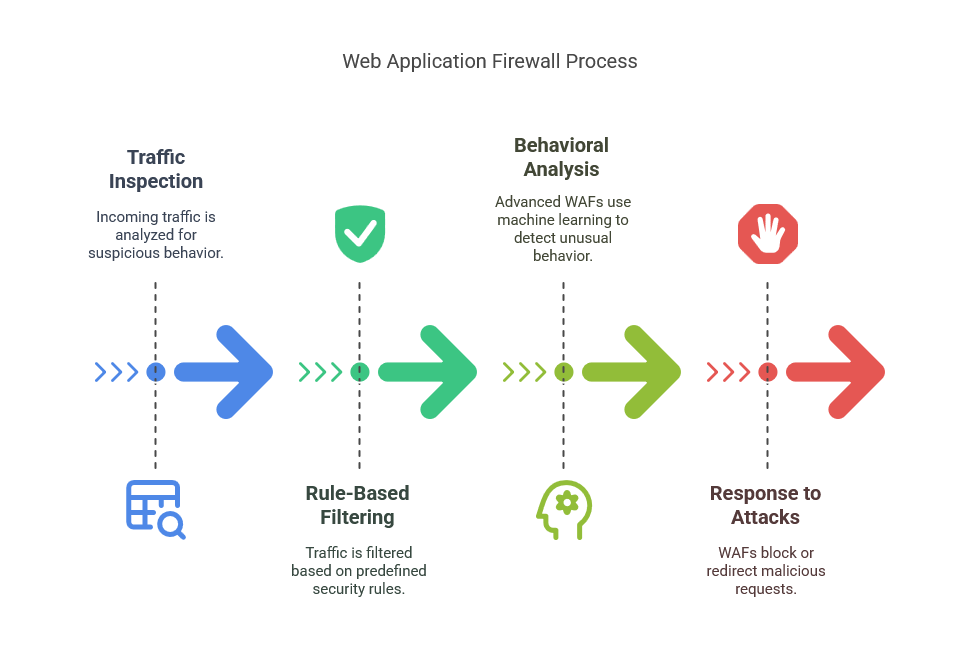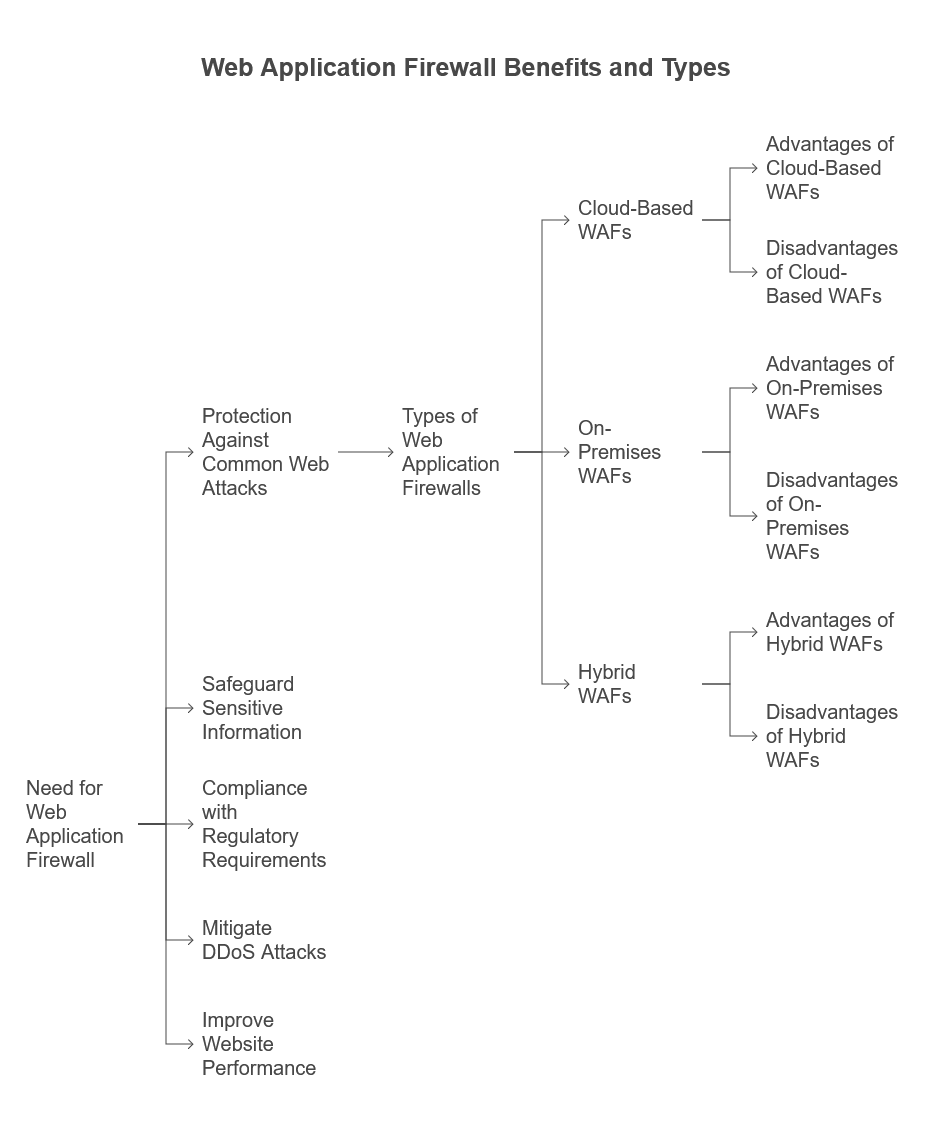In today’s online environment, website security has become a significant concern for businesses, developers, and users. Websites are constantly threatened by malicious attacks, ranging from hacking attempts to data breaches and Distributed Denial of Service (DDoS) attacks. One effective solution that has emerged to combat these dangers is the Web Application Firewall (WAF). This article will explore a WAF, how it works, and why it’s crucial for protecting your website from cyber threats.
According to a report by Imperva, over 50% of web traffic is generated by bots, and a significant portion of this traffic is malicious. This highlights the importance of having a WAF to filter out harmful traffic before it reaches your website. Furthermore, a study by OWASP found that over 75% of all web application attacks target vulnerabilities in third-party software, which a WAF can mitigate.
What is a Web Application Firewall?
A Web Application Firewall (WAF) is a specialised security system that filters, monitors, and controls incoming and outgoing HTTP traffic between a web application and the internet. Unlike traditional firewalls that protect against network-level threats, a WAF focuses on web-specific attacks that target vulnerabilities within web applications. These vulnerabilities often include attacks like SQL injection, cross-site scripting (XSS), file inclusion, etc.
WAFs are often deployed to prevent attacks that can exploit web application security flaws. They are typically used to defend websites, web servers, and APIs by acting as a barrier between the user and the web server, filtering harmful traffic before it reaches the web application.
How Does a Web Application Firewall Work?
A WAF analyses HTTP requests that enter the web server and filters out malicious ones. It can block attacks before they reach the server or allow requests based on the user’s security rules. The basic functioning of a WAF involves several key steps:
-
Traffic Inspection: All incoming traffic is inspected for suspicious behaviour, like unusual request patterns or harmful payloads. This inspection happens at the web application level, crucial for detecting vulnerabilities in the application’s code.
-
Rule-Based Filtering: WAFs operate based on predefined rules or patterns identifying known attack vectors. These rules can detect common attack types like SQL injections, XSS, and buffer overflows. A request will be blocked automatically if it matches any of the rules.
-
Behavioural Analysis: Some advanced WAFs use machine learning and behaviour analysis to monitor traffic. Suppose the system detects unusual or suspicious behaviour, such as a sudden spike in traffic or repeated login attempts. In that case, it can take action, such as blocking an IP address or rate-limiting requests.
-
Response to Attacks: After detecting a threat, the WAF can either block the malicious request, redirect it, or return a specific response, such as a 403 Forbidden error. By blocking these malicious requests at the edge, the WAF prevents them from affecting the website.

Why Do You Need a Web Application Firewall?
A Web Application Firewall is essential for businesses that want to protect their websites and web applications from cyber threats. Here’s why a WAF is crucial:
1. Protection Against Common Web Attacks
Many cyberattacks target vulnerabilities in web applications. SQL injections, cross-site scripting (XSS), and file inclusion attacks are among the most common. According to the OWASP (Open Web Application Security Project), these attacks are widespread and often go unnoticed without proper security measures like a WAF. A WAF can block these attacks by filtering malicious traffic before it reaches the application.
2. Safeguard Sensitive Information
Websites often handle sensitive data, such as customer information, payment details, and login credentials. If this information falls into the wrong hands, it can lead to identity theft, financial loss, and damage to your brand reputation. A WAF helps secure this sensitive data by preventing unauthorised access and data breaches.
3. Compliance with Regulatory Requirements
Websites like healthcare, finance, and e-commerce must comply with strict data security regulations. For example, HIPAA for healthcare and PCI-DSS for the payment card industry require businesses to ensure robust security measures are in place to protect data. A WAF can help companies to stay compliant by securing web applications and preventing data leaks.
4. Mitigate DDoS Attacks
A Distributed Denial of Service (DDoS) attack aims to overwhelm a website or server by flooding it with traffic, rendering it inaccessible to legitimate users. WAFs help mitigate the effects of DDoS attacks by filtering out malicious traffic and allowing legitimate traffic to reach the website. This keeps the website operational during large-scale attacks.
5. Improve Website Performance
In addition to security, a WAF can improve website performance by reducing the load on your server. By blocking harmful traffic, the WAF ensures that only legitimate requests reach your application. This can help reduce the server’s load and improve the speed and responsiveness of your website.
Types of Web Application Firewalls
There are three main types of WAFs, each offering different deployment options:
1. Cloud-Based WAFs
Cloud-based WAFs are hosted on the cloud and protected without needing on-premises hardware. Third-party vendors manage them and typically offer scalability and flexibility. Popular cloud-based WAF providers include Cloudflare, Akamai, and Amazon Web Services (AWS).
Advantages:
-
Easy to deploy and scale.
-
No need for dedicated hardware.
-
Managed service with automatic updates.
Disadvantages:
-
Less control over configuration.
-
May have latency issues for specific regions.
2. On-Premises WAFs
On-premises WAFs are installed directly on your server or within your network infrastructure. These WAFs offer complete control over the configuration and rules, allowing businesses to tailor them to specific needs. However, they require more maintenance and resources.
Advantages:
-
Complete control over security settings.
-
Can be customised to meet specific requirements.
Disadvantages:
-
Higher upfront cost.
-
Requires technical expertise to configure and maintain.
3. Hybrid WAFs
Hybrid WAFs combine both cloud-based and on-premises solutions. They offer the flexibility of cloud WAFs while providing control over on-premises firewalls. This option is ideal for businesses that want the best of both worlds.
Advantages:
-
Flexibility and control.
-
Can be deployed to suit specific business needs.
Disadvantages:
-
It can be complex to manage.
-
Higher cost than cloud-based solutions.

How to Choose the Right Web Application Firewall?
Choosing the right WAF for your website depends on several factors. Here’s what you need to consider when selecting a WAF:
1. Website Traffic
High-traffic websites may require cloud-based WAFs due to their scalability and ability to handle significant traffic. On the other hand, smaller websites with less traffic may benefit from on-premises solutions.
2. Budget
Cloud-based WAFs are generally more cost-effective since they don’t require physical hardware installation. On-premises solutions require more investment in hardware and resources but provide more control.
3. Compliance Needs
If your website handles sensitive data or falls under specific regulations, ensure that the WAF you choose meets compliance standards, such as GDPR or HIPAA.
4. Ease of Use
WAFs vary in terms of user-friendliness. Some solutions offer intuitive dashboards and easy setup processes, while others may require more technical expertise. Make sure to choose one that suits your team’s capabilities.
Benefits of Using a Web Application Firewall
In addition to preventing attacks, a Web Application Firewall offers several benefits to your website:
-
Real-Time Protection: A WAF works in real-time to block threats before they reach your web server.
-
Reduced Risk of Data Breaches: By blocking malicious traffic, a WAF helps prevent data leaks and protects sensitive information.
-
Customizable Protection: Many WAFs allow you to set custom rules, providing tailored protection for your website.
Implementing a Web Application Firewall
Implementing a Web Application Firewall typically involves the following steps:
-
Select a WAF Provider: Choose a WAF solution based on your needs, traffic volume, and budget.
-
Configure Your WAF: Once the WAF is deployed, configure it to monitor and block malicious traffic.
-
Test and Monitor: Regularly test the WAF’s effectiveness and monitor its performance to ensure optimal protection.
Frequently Asked Questions About Web Application Firewalls
1. What is a Web Application Firewall (WAF)?
A WAF is a security system that filters and monitors HTTP traffic between a web application and the internet. It protects websites from attacks like SQL injections and XSS.
2. Why do I need a WAF?
A WAF is essential for protecting your website from common web application attacks and securing sensitive data. It also helps maintain compliance with industry regulations.
3. Can a WAF improve website performance?
Yes, by blocking harmful traffic, a WAF reduces the load on your server, leading to faster website performance.
4. What are the different types of WAFs?
There are cloud-based, on-premises, and hybrid WAF solutions, each offering different levels of control and scalability.
5. How do I set up a WAF?
To set up a WAF, choose a provider, configure the WAF to monitor your traffic, and regularly monitor its performance to ensure it effectively blocks threats.
A Web Application Firewall (WAF) is an essential tool for anyone who owns or manages a website. It helps protect your website from malicious attacks, secures sensitive data, and ensures compliance with industry regulations. Whether you opt for a cloud-based solution or an on-premises WAF, securing your website with a WAF is crucial in today’s increasingly digital world.

